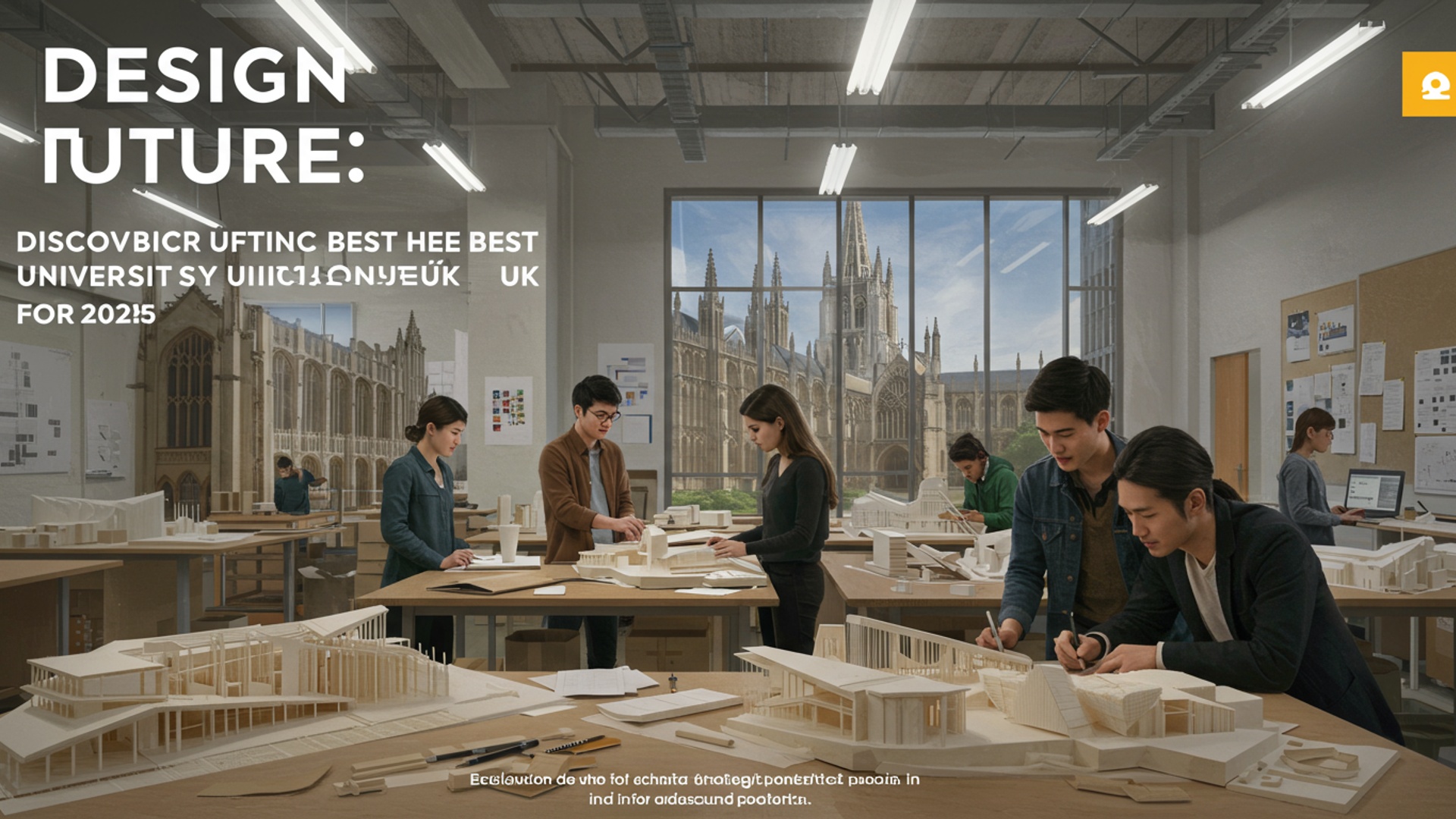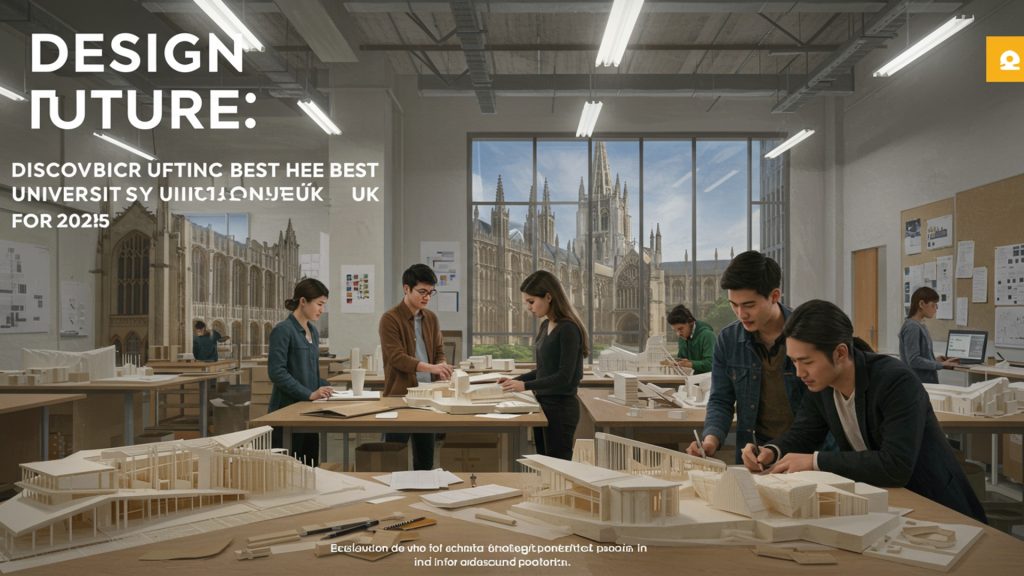Embarking on an architectural career in 2025 demands more than design flair; it requires a deep understanding of evolving global challenges and cutting-edge technologies. Future architects must master sustainable practices, integrate smart building systems. navigate the complexities of urban regeneration, often leveraging AI-driven design tools and advanced digital fabrication techniques. The UK stands as a pivotal hub for this transformative education, consistently producing graduates who shape our built environment. Identifying the top architecture universities in the UK is crucial for aspiring professionals seeking programs that blend historical reverence with pioneering research in areas like biomimicry and circular economy principles, preparing them to lead the next wave of impactful design.

Understanding the Path to Becoming an Architect in the UK
Embarking on a career in architecture is an incredibly exciting journey, one that allows you to shape the physical world around us, designing spaces that inspire, function. stand the test of time. For aspiring architects, the United Kingdom offers some of the most prestigious and innovative educational pathways globally. Before diving into the specifics of which institutions stand out, it’s crucial to comprehend the foundational structure of architectural education in the UK, particularly the role of the Royal Institute of British Architects (RIBA).
The path to becoming a fully qualified architect in the UK is typically a multi-stage process, accredited by RIBA, ensuring a rigorous and high-quality education. This journey is commonly broken down into three parts:
- RIBA Part 1
- RIBA Part 2
- RIBA Part 3
This is typically a three-year undergraduate degree (BA or BSc in Architecture). During this stage, you’ll develop core design skills, learn about architectural history and theory, construction technology. environmental design principles. Many of the top architecture universities in the UK offer exceptional Part 1 programmes that lay a robust foundation.
Following Part 1, students usually undertake a minimum of one year of practical experience in an architectural practice before returning for a two-year Master of Architecture (MArch) or Diploma. This stage deepens your understanding, focuses on complex design projects. often involves more specialized research.
After completing Part 2 and accumulating a further period of practical experience (typically 12-24 months), candidates can sit the Part 3 examination. This involves a professional practice and management examination, culminating in registration with the Architects Registration Board (ARB), allowing you to use the title ‘architect’.
Understanding this structured progression is vital as you explore university options, ensuring that your chosen programme aligns with your long-term professional aspirations. The calibre of education at a top UK institution significantly impacts your readiness for each stage and, ultimately, your success in the profession.
What Defines a World-Class Architecture Programme?
When searching for the top architecture universities in the UK, it’s not just about flashy buildings or historical prestige. A truly world-class architecture programme offers a holistic educational experience that prepares students not just for practice. for leadership and innovation in the field. Here are some key elements to look for:
- Innovative Curriculum and Pedagogy
- Exceptional Studio Culture
- Renowned Faculty and Industry Links
- Resources and Facilities
- Research Excellence and Specializations
- Global Perspective and Exchange Opportunities
The best programmes move beyond traditional teaching, incorporating cutting-edge technologies like parametric design, virtual reality (VR). building details modelling (BIM). They encourage critical thinking, interdisciplinary collaboration. design-led research.
Architecture is an intensely studio-based discipline. A vibrant, supportive. challenging studio environment is paramount. Look for universities with dedicated studio spaces, access to workshops (wood, metal, digital fabrication). a strong sense of community where students learn from each other as much as from their tutors.
Learning from leading architects, researchers. practitioners is invaluable. Top universities attract faculty who are actively engaged in the profession, bringing real-world insights and connections. Strong links with architectural firms, professional bodies. alumni networks provide opportunities for internships, mentorship. career placement.
Beyond studio space, access to state-of-the-art libraries, digital labs, model-making workshops. material research facilities significantly enhances the learning experience. Some universities even boast dedicated fabrication labs with robotic arms or advanced 3D printers, pushing the boundaries of what’s possible in design and construction.
Many top programmes are embedded within research-intensive universities, offering opportunities to engage with groundbreaking research in areas like sustainable design, urbanism, heritage, or digital fabrication. This can open doors to specialized career paths or further academic pursuits.
Architecture is a global profession. Universities that offer international exchange programmes, study trips, or a diverse student body provide invaluable exposure to different cultures, contexts. design philosophies.
Consider, for instance, a programme that integrates a strong focus on sustainable urban development, a crucial aspect of modern architecture. Such a programme might involve real-world case studies of urban regeneration projects, inviting guest lecturers from leading sustainable design firms. offering studio projects that tackle contemporary environmental challenges. This immersive approach ensures graduates are not just skilled designers but also socially and environmentally conscious professionals.
Spotlight on the Top Architecture Universities in the UK for 2025
While rankings can fluctuate, certain institutions consistently feature among the top architecture universities in the UK, celebrated for their academic rigor, innovative teaching. exceptional graduate prospects. It’s vital to remember that the “best” university is subjective and depends on your individual learning style and career aspirations. But, based on consistent performance in various league tables (like QS World University Rankings by Subject, The Guardian University Guide. The Complete University Guide), alongside reputation for research and student satisfaction, here’s a closer look at some of the leading contenders:
University College London (UCL) – The Bartlett School of Architecture
- Distinction
- What stands out
- Real-world Application
Consistently ranked among the top global architecture schools. The Bartlett is renowned for its experimental and innovative approach to design, pushing boundaries in digital fabrication, urban design. architectural theory.
Its vibrant, challenging studio culture, world-class facilities including extensive workshops and digital fabrication labs. a strong emphasis on research-led design. Graduates are highly sought after by leading international firms.
Bartlett students often engage with complex urban challenges in London and beyond, producing visionary projects that explore future architectural possibilities. Their alumni network is incredibly influential, providing excellent career pathways.
University of Cambridge
- Distinction
- What stands out
- Comparison Point
Offers a highly academic and intellectually rigorous approach to architecture, integrating history, theory. practical design.
A strong emphasis on critical thinking and research, often exploring the philosophical and cultural dimensions of architecture. The programme benefits from the university’s overall academic excellence and rich historical context.
Compared to UCL’s experimental focus, Cambridge often appeals to students seeking a more traditional yet deeply intellectual grounding in the discipline, preparing them for roles that require strong analytical and theoretical capabilities.
University of Bath
- Distinction
- What stands out
- Actionable Takeaway
Highly regarded for its strong technical and practical focus, often integrating a year of professional placement within its undergraduate programme.
Excellent links with industry, ensuring students gain valuable real-world experience. Their courses are known for their strong emphasis on construction technology, structural design. environmental performance.
If hands-on experience and a direct path to professional practice are your priorities, Bath’s integrated placement year is a significant advantage, setting graduates apart in the job market.
University of Sheffield
- Distinction
- What stands out
- Case Study Example
Known for its strong community feel, excellent student satisfaction. a focus on socially engaged and environmentally responsible architecture.
A diverse range of research units and design studios that tackle contemporary issues like sustainable urbanism, community engagement. digital architecture. The school has a reputation for nurturing well-rounded and ethically conscious architects.
Sheffield’s “Live Projects” programme allows students to work on real-world design briefs for community clients, providing invaluable practical experience and a direct impact on local areas. This type of experiential learning is a hallmark of the school’s commitment to relevant, impactful design.
Manchester School of Architecture (MSA) – University of Manchester & Manchester Metropolitan University
- Distinction
- What stands out
- Real-world Application
A unique collaboration that combines the resources and expertise of two major universities, offering a broad and dynamic learning environment.
Its location in a vibrant, architecturally diverse city provides a living laboratory for urban studies. MSA is known for its strong focus on urbanism, sustainable design. digital technologies.
Students frequently engage with Manchester’s regeneration projects, offering practical insights into large-scale urban development and the challenges of modern city planning.
Loughborough University
- Distinction
- What stands out
Strong reputation for its technical excellence, particularly in areas like building performance, materials science. sustainable construction.
State-of-the-art facilities for material testing and environmental simulation, providing a hands-on approach to understanding how buildings perform. Excellent graduate employability, often in roles focused on the technical aspects of architecture.
University of Edinburgh
- Distinction
- What stands out
Offers a rich historical and cultural context for architectural study, situated in a city famous for its unique blend of historic and contemporary architecture.
A strong emphasis on architectural history, theory. conservation, alongside contemporary design challenges. The school benefits from its interdisciplinary connections within a world-class university.
This is not an exhaustive list. other fantastic institutions like Cardiff University, the University of Nottingham, Newcastle University. Oxford Brookes University also consistently feature among the top architecture universities in the UK, each with their own unique strengths and specializations.
Beyond the Rankings: Factors to Consider When Choosing Your University
While league tables offer a great starting point, they don’t tell the whole story. Choosing the right architecture university is a deeply personal decision. Here’s a table comparing crucial factors beyond mere rankings, helping you make an informed choice:
| Factor | Description | Why it Matters for Architecture Students | Questions to Ask Yourself |
|---|---|---|---|
| Course Structure & Specializations | Does the programme offer specific pathways (e. g. , urban design, sustainable architecture, conservation)? What’s the balance between design studio, lectures. practical work? | Ensures the curriculum aligns with your specific interests and career goals. Some programmes are more design-heavy, others more theoretical or technical. | Do I prefer a programme with a strong technical focus, or one that’s more experimental? Am I interested in a particular specialization early on? |
| Studio Culture & Resources | What are the dedicated studio spaces like? Are they accessible 24/7? What workshops (model making, digital fabrication, laser cutting) are available and how accessible are they? | Architecture is highly practical. Excellent facilities and a supportive, collaborative studio environment are critical for learning and project development. | Do I thrive in an intensive, competitive environment, or a more collaborative and nurturing one? How essential is access to advanced workshops for my learning style? |
| Faculty & Research Interests | Who are the tutors? What are their areas of expertise and active research? Do they have strong industry links? | Learning from leading practitioners and researchers can inspire and open doors to internships and career opportunities. Their specializations might align with yours. | Are there particular architects or research areas that excite me? Do the faculty’s backgrounds align with my aspirations? |
| Location & City Context | Is the university in a bustling city, a historic town, or a more rural setting? How does the built environment of the location inform the teaching? | The surrounding environment serves as a living laboratory for architects. A city with diverse architecture, ongoing urban projects. cultural institutions can enrich your studies. | Do I want to study in a large, vibrant city with diverse architecture, or a smaller, more focused academic environment? How will the location impact my daily life and studies? |
| Student Support & Community | What academic and pastoral support is available? Is there a strong student society or peer network? | Architecture degrees can be demanding. A supportive community and accessible resources are vital for wellbeing and success. | How essential is a strong sense of community and support network to me? What student societies or clubs are available? |
| Employability & Alumni Network | What are the graduate employment rates? Where do graduates typically work? How strong is the alumni network? | A university with strong industry connections and a reputable alumni base can significantly boost your career prospects after graduation. | What kind of firms or roles do I aspire to work in? How does the university support career development and placements? |
For example, if you are passionate about sustainable design, a university with a dedicated research centre for environmental architecture and faculty actively publishing in that area might be a better fit for you than one known primarily for its digital fabrication prowess, even if both are considered among the top architecture universities in the UK.
Crafting Your Winning Application and Portfolio
Gaining admission to the top architecture universities in the UK is highly competitive. your application, particularly your portfolio, is key. This is where you demonstrate your passion, creativity. potential. Here’s what you need to focus on:
- Academic Excellence
- The Personal Statement
- The Architecture Portfolio
- Content
- Process over Product
- Originality and Personality
- Presentation
- Interviews
Strong grades in relevant subjects (often including art, design, maths, or physics) are a prerequisite. Universities will look at your predicted and achieved A-Level, IB, or equivalent qualifications.
This is your opportunity to articulate your genuine interest in architecture. Be specific. Why architecture? What inspires you? What have you done to explore your interest (e. g. , work experience, workshops, reading)? Connect your experiences to the skills required for architecture, such as problem-solving, creativity. spatial awareness. Avoid generic statements; let your unique voice shine through.
This is arguably the most critical component of your application. It’s not just a collection of your best art pieces; it’s a visual narrative of your creative process and potential.
Include a range of work that demonstrates your drawing skills (observational, analytical), model-making abilities, understanding of space. creative thinking. This could include sketches, paintings, sculptures, photography, technical drawings, or even digital art.
Universities want to see how you think. Include developmental sketches, iterative models. annotations that explain your ideas, inspirations. the evolution of your projects. Show your thought process, not just the final outcome.
Let your unique perspective come through. Don’t try to guess what they want to see; instead, present work that genuinely represents your interests and capabilities.
Your portfolio should be well-organised, clear. easy to navigate, whether in physical or digital format. Pay attention to layout, composition. clarity.
Some universities will invite you for an interview, often in conjunction with a portfolio review. This is your chance to discuss your work, expand on your personal statement. demonstrate your enthusiasm and suitability for the programme. Be prepared to discuss your inspirations, your approach to design. why you believe you’d be a good fit for their specific programme.
As an actionable takeaway, begin building your portfolio early. Attend portfolio preparation workshops, seek feedback from art teachers or practicing architects. continuously refine your work. Remember, every piece in your portfolio tells a story about you as a potential architect.
Life as an Architecture Student and Beyond
Studying architecture at one of the top architecture universities in the UK is an immersive and demanding, yet incredibly rewarding experience. It’s a journey of intense creativity, critical thinking. collaborative work. You’ll spend countless hours in the studio, grappling with design challenges, experimenting with materials. presenting your ideas. Expect late nights, passionate debates. the immense satisfaction of seeing your concepts take shape, whether on paper, as a model, or in a digital rendering.
Beyond the studio, you’ll engage with lectures, seminars. site visits, building a comprehensive understanding of architectural history, theory, technology. professional practice. Many programmes offer international study trips, providing invaluable exposure to diverse architectural styles and urban contexts. You’ll develop a unique set of transferable skills:
- Problem-solving
- Critical thinking
- Visual communication
- Project management
- Collaboration
- Resilience
Tackling complex design briefs with innovative solutions.
Analysing and evaluating architectural concepts and built environments.
Mastering various forms of representation, from hand drawing to advanced digital modelling.
Juggling multiple projects, deadlines. resources.
Working effectively in teams with peers and professionals.
Learning from critiques and adapting your designs.
The architectural community in the UK is vibrant and supportive. You’ll have opportunities to join student societies, attend guest lectures by world-renowned architects. participate in design competitions. These experiences not only enrich your academic life but also build your professional network, which is crucial for future career success.
Upon graduation from a RIBA Part 1 programme, you’ll be well-equipped for initial roles in architectural practices, design consultancies, or related fields. Many graduates choose to gain practical experience before pursuing their Part 2 (Master’s) qualification. The skills you acquire are highly versatile, opening doors to careers not only in traditional architectural practice but also in urban planning, interior design, landscape architecture, construction management, film set design, product design. even software development or academia. The foundational education received at the top architecture universities in the UK truly prepares you to design your future, no matter which path you ultimately choose to pursue.
Conclusion
As you embark on designing your future within the vibrant UK architecture scene for 2025, remember that true success lies beyond rankings. Your research into institutions like the progressive Manchester School of Architecture or the historically rich Architectural Association should now translate into action. Consider deeply how a university’s specialisation—perhaps in sustainable urban design or cutting-edge digital fabrication—aligns with your unique vision for shaping our built environment. My personal advice: visit campuses if possible, engage with current students. trust your intuition; the ‘feel’ of a place is invaluable. The architectural landscape is rapidly evolving, embracing smart cities and climate-resilient designs. Begin refining your portfolio now, showcasing not just skill. your passion and critical thinking, as this is your most powerful statement. This journey isn’t just about selecting a university; it’s about laying the foundation for a career where your creativity will literally transform the world. Your future masterpiece begins with this crucial decision.
More Articles
Exploring Diverse Architecture University Programs Across the United Kingdom.
Your Complete Guide to Engineering Colleges in Germany: Admissions and Beyond.
Apply for GATE Exam: A Complete Step-by-Step Guide for Seamless Application
Your Future in Biotech: Essential Skills and High-Paying Roles Explained
Navigating Biotech Careers: Top Jobs and Earning Potentials in 2025
FAQs
What’s the big idea behind ‘Design Your Future: Discovering the Best Architecture Universities in the UK for 2025’?
This guide is your ultimate resource for exploring top architecture programs across the UK specifically for the 2025 intake. It’s designed to help aspiring architects navigate the many excellent options available, providing insights into what makes certain universities stand out and how to find the perfect fit for your unique ambitions.
Why should I even consider studying architecture in the UK?
The UK holds a world-renowned reputation for architectural education, blending deep historical heritage with cutting-edge design and technology. You’ll benefit from innovative teaching methods, diverse cultural environments. strong industry connections, all setting you up for a truly global career in architecture.
When’s the best time to start thinking about applying for 2025 programs?
It’s honestly never too early to start! While specific application deadlines for 2025 entry generally fall in mid-January 2025, applications typically open around early September 2024. But, preparing a strong portfolio and a compelling personal statement takes significant time, so getting a head start in late 2023 or early 2024 is highly recommended.
What criteria did you use to pick the ‘best’ architecture universities?
We’ve looked at a mix of vital factors including academic reputation, quality of teaching and research, industry links, student satisfaction, the standard of facilities. graduate employability rates. Ultimately, ‘best’ is subjective, so the guide aims to help you weigh these elements to find what truly aligns with your personal goals and learning style.
Do I really need an architecture portfolio to apply. what should be in it?
Absolutely, a strong portfolio is usually a crucial part of your application for architecture courses. It’s your chance to showcase your creative potential, drawing skills, spatial awareness. genuine passion for design. Don’t feel it has to be all architectural drawings; include a range of creative work from sketches to models, photography, or even digital art that demonstrates your unique perspective and thought process.
Are all UK architecture courses pretty much the same, or are there different types?
Not at all! While most undergraduate courses lead to a Part 1 qualification (ARB/RIBA accredited), there’s a huge amount of variety in focus. Some programs are more design-intensive, others might lean heavily into technology, sustainability, urban planning, or even architectural history. It’s definitely worth researching specific course structures and modules to see which approach resonates most with your interests.
What kind of job opportunities are there after graduating with a UK architecture degree?
A UK architecture degree opens doors to a surprisingly wide range of careers. While many graduates go on to become qualified architects, you can also explore exciting roles in urban design, landscape architecture, interior design, construction management, heritage conservation, set design, or even positions in policy, research. academia. The critical thinking and creative problem-solving skills you gain are highly transferable!



